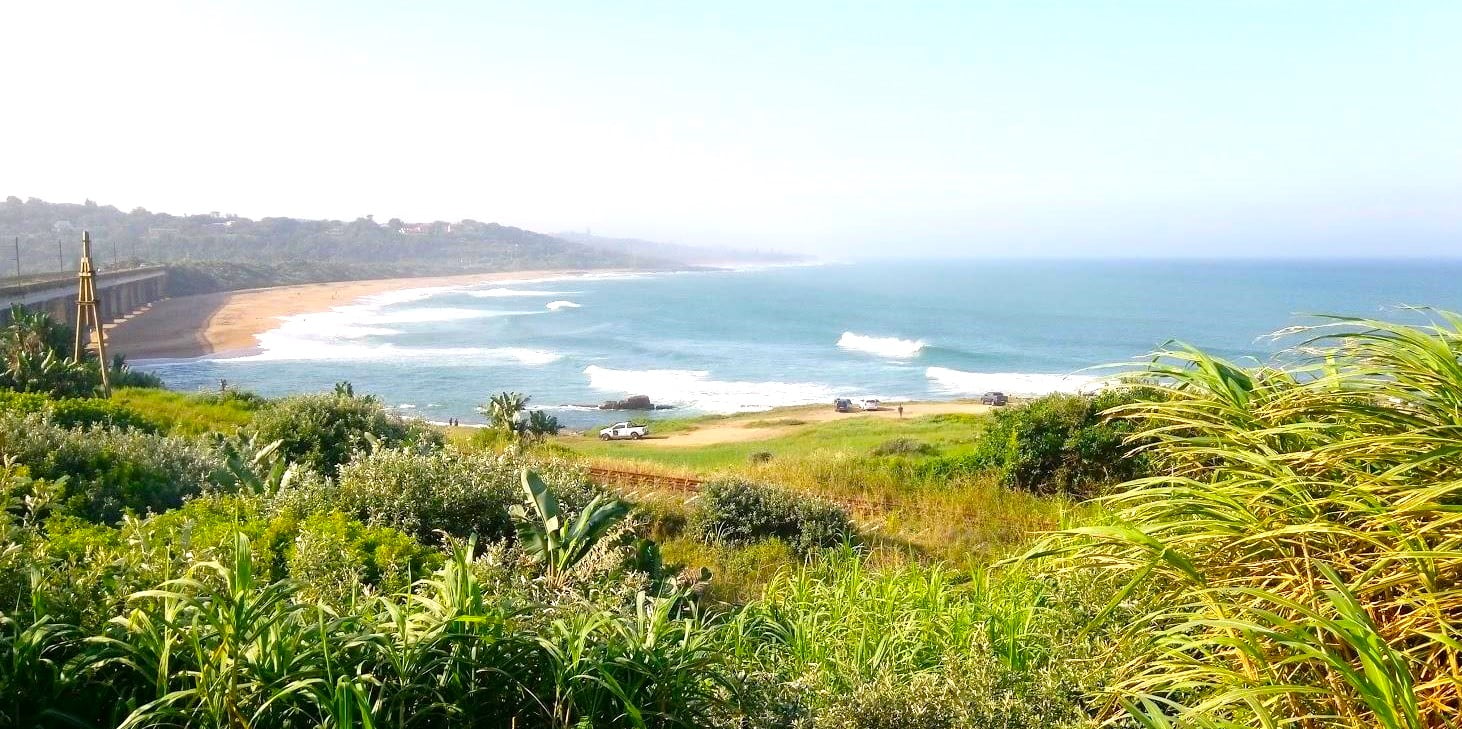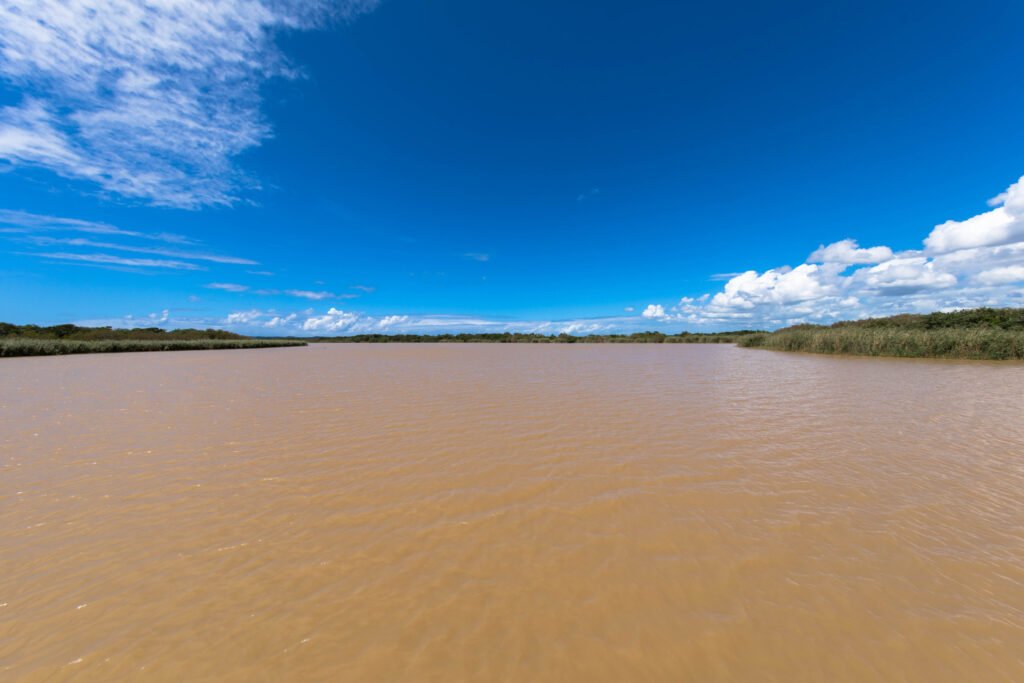“No man is as wise as Mother Earth. She has witnessed every human day, every human struggle, every human pain and every human joy”
The mighty uMzimkulu River plays a critical role in supporting biodiversity of the South Coast of KwaZulu-Natal, providing water, food and habitat for millions, on the land as well as in the water.
It seems to spring quite miraculously from a rock face high in the Lesotho highlands, where ancient fault lines converge in an aquifer. It appears as little more than a stream that flows over stony ground, but quickly grows as it moves down through the mountains, unstoppable in its determination to reach the Indian Ocean. It travels over 400 kilometres to fulfil the destiny it has followed for billions of years, gathering momentum along its route. Along the way, myriad tributaries join the river course, adding to the volume of water and enriching it with minerals from all the different rocks along its course. Plant spores and seeds, as well as little fish and crustaceans come along for the ride, spreading their life force through the vast and intricate web of life that is uMzimkulu. The river supports life all along its banks, feeding magnificent forests on its banks, sparkling through the spectacular uMzimkulu Gorge and eventually reaching the ocean at Port Shepstone.
Thanks to the fact that the river is largely protected under law and unobstructed by man-made barriers such as dams, its natural flood pulse provides the minerals needed by biological organisms, the riverbed creates safe spots for small fish and prawns to live and feed in and excess sand and contaminants are flushed into the sea.
The estuary, which extends some 10 kilometres inland from the coastline, is an area of critical importance for biodiversity, as this is where the freshwater river and salty ocean meet. Many aquatic species need to move between fresh and saline water, as many live in the ocean but breed in fresh water, or vice versa. Crabs, prawns and as many as 170 species of fish live in South African estuaries. The rich biodiversity in the uMzimkulu estuary directly feeds offshore marine areas like Aliwal Shoal and Protea Banks, as well as supporting the annual whale migration and sardine run. This level of biodiversity is more than just a luxury for ‘bunny huggers’ – it forms the backbone of tourism in the region, which is one of the most important drivers of the local economy; furthermore, many communities, especially inland, depend on the river to provide them with food and livelihoods.
Many people would be surprised to learn that the uMzimkulu estuary was a ‘dead zone’ for many years. According to Brian Lange, who has lived and fished on the river since 1980, the water was too contaminated to swim in during the 1980s and 90s, and very little wildlife was to be found in the estuary. Brian cites two reasons for this: The presence of raw sewage in the water and the use of herbicides containing glyphosate (the active ingredient in products such as RoundUp) by sugar farmers upstream. Glyphosate is a non-selective herbicide that kills most plants and it seems likely that the loss of vegetation in the river reduced the habitat required by many aquatic species. In the late 1990s, the farmers stopped using glyphosate-based herbicides. The ‘hundred-year flood’ of 2006 scoured the river, effectively flushing out herbicide residue … and then everything changed. The number and variety of fish and other wildlife in the estuary began to increase and today uMzimkulu Estuary is home to turtles, otters, monitor lizards and at least 40 species of fish including kingfish, tarpon, Zambezi sharks and kob. Thanks to one simple change in farming practices, the estuary has been able to heal itself and recover and, these days, it is a thriving and sought-after destination for fishing, paddling and boat cruises.
The story of uMzimkulu estuary reminds us that all life is connected and that, although human activities can do a lot of damage, it often takes just small adjustments in understanding and human activities for Nature to heal and for life to thrive. Just as this mighty river has recovered, so the land and all who live on it can recover and serve as a foundation for prolific biodiversity and human abundance.
Reforestation and phytoremediation
Vast areas of land around the world, including South Africa, have been denuded over the last few centuries, primarily to make way for human settlements and large-scale agriculture. The Sahara Desert is an example to bear in mind: As recently as 6 000 years ago, the area was covered in forests, but the steady removal of trees and the diversion of water for agricultural use steadily exposed the topsoil, rendering it unable to maintain its structural integrity and leaving human communities with little more than pockets of oases for survival. Since 2007, however, the Great Green Wall initiative has begun to restore the southern edge of the Sahara, providing millions of jobs, regenerating the soil and providing food for local communities. The initiative hopes to restore 100 million hectares of land between Senegal in the west and Djibouti in the east, creating a mosaic of trees, vegetation, grasslands and plants 15 kilometres wide and 8 000 kilometres long. So far, the project has restored over 14 000 hectares of land in Burkina Faso; 15 million hectares in Ethiopia; 300 hectares in Somalia; and 4.9 million hectares in Nigeria.
Although South Africa is nowhere near as desertified as the countries bordering the Sahara, deforestation has had a significant impact on soil stability, water availability and biodiversity. Removing trees from the environment contributes to soil erosion, which reduces the nutrients in topsoil and increases the possibility of landslides and mudslides during heavy rains. Gardens protect homes and forests protect cities, industry and agricultural holdings from the effects of flooding.
One result of our benign climate is that many plant species thrive in South Africa. Alien Invasive Plants (AIPs), most of which have been introduced without any idea of how they could take over without the natural predators and climatic limitations found in their home countries, are very problematic in South Africa. AIPs reduce the water available in our rivers, groundwater and topsoil, with researchers estimating that we lose at least 14 per cent of our freshwater to ‘thirsty’ plants such as bluegums; many AIPs are toxic to humans and livestock and most displace indigenous plants and reduce habitat and food required by indigenous wildlife. Projects that remove AIPs and restore indigenous vegetation can go a long way towards restoring water availability, soil stability and biodiversity. Start small – remove AIPs in your own garden and pavement and plant indigenous trees, shrubs, grasses and flowers that belong in your area. Specific information about these plants can be found at www.sanbi.org, www.invasives.org.za, www.theindigenousgardener.co.za and many other online sources.
Mother Earth is strong, resilient and infinitely generous in providing us with food, shelter, building materials and medicine. Many plants naturally absorb contaminants and clean water and soil, in a process known as phytoremediation. All plants sequester carbon dioxide and produce oxygen and many ‘common’ indigenous plants are excellent environmental cleansers. For example, spekboom is an outstanding air purifier; agapanthus removes petrochemicals from soil and indigenous grasses and duckweed can remove heavy metals from water. Strelitzias, bullrushes and arum lilies purify wastewater and grey water and make a beautiful addition to areas around french drains, septic tanks, sewage pumps and pit latrines.
Regenerative agriculture
Small-scale organic farming and permaculture provide gardeners with a wide variety of food that is fresh, clean, affordable and highly nutritious. Growing our own food increases our ability to take care of ourselves, regardless of the vagaries of social unrest, political turbulence and economic uncertainty and also helps create a buffer against the effects of climate change at the local level.
Many large-scale farmers are moving away from monocrops and are using regenerative farming practices to reduce their reliance on synthetic fertilisers and toxic herbicides and pesticides. Similarly to small-scale farming, regenerative agriculture begins with restoring and building soil health by incorporating no-till planting, increasing biomass in the soil (compost), utilising companion planting (growing a variety of compatible plants together), incorporating plants that deter pests (such as marigolds), incorporating indigenous plants to attract pollinators and predator insects that eat common agricultural pests and using ‘green compost’ (such as comfrey) to feed their crops and provide mulch. All these practices help to strengthen crops, save water and reduce pests, while strengthening topsoil in the long term and making food production more sustainable on every level. Information about regenerative agriculture may be found on various websites and social media platforms, including www.regenagsa.org.za, www.terramanzi.co.za, www.regenz.co.za and www.grounded.co.za.
Restoring the health of our air, soil, water and ecosystems requires some re-education and quite a bit of physical effort (which translates directly into job creation), but the results are hugely rewarding. Thanks to the power of Nature, we can achieve a lot with simple shifts – as in the case of the uMzimkulu where one small change in human input has been enough for the river to heal itself. Everyone, from home gardeners to commercial farmers, industries and businesses, is able to find simple changes they can make to help Nature restore the balance and re-establish vibrant biodiversity.


Helen Dodge is the founder of The Green Net, a community-based environmental organisation on the South Coast of KwaZulu-Natal. The group provides environmental education, facilitates networking and undertakes practical projects to protect and nurture the natural environment and its residents. These include activities that help rivers (such as the removal of litter and alien invasive plants, rehabilitation of riparian zones and phytoremediation); reforestation and the establishment of organic food gardens to restore soil and promote food security; waste management initiatives including recycling and EcoBrick projects; the promotion of sustainable building materials, particularly hempcrete; supporting ecotourism initiatives in the region; and environmental advocacy through increasing community awareness of – and objections to – polluting and/or illegal activities such as offshore mining, illegal sand mining, the unnecessary damming of rivers and other activities that threaten biodiversity and exacerbate the impacts of climate change.


